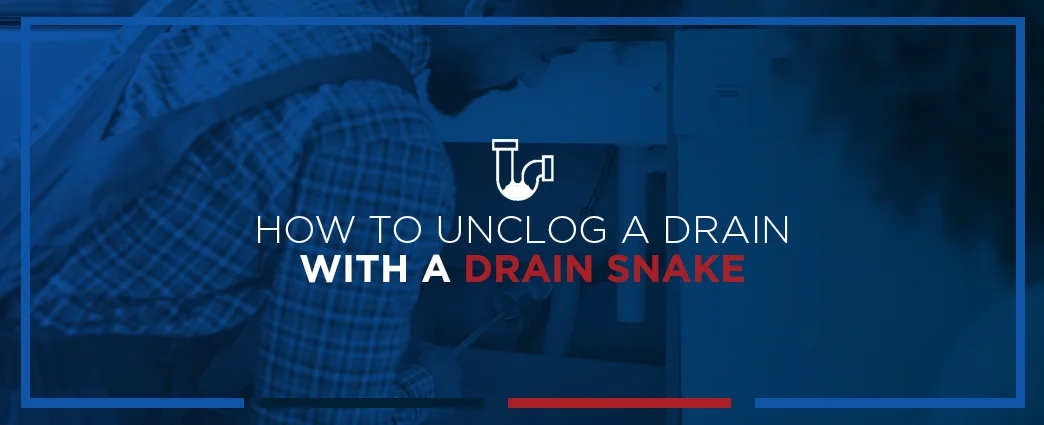
Table of Contents:
- When Should I Use a Drain Snake?
- What Are the Pros and Cons of Using a Snake?
- What Are the Different Types of Drain Snakes?
- Drain Snake vs. Hanger: Can I Use a Wire Hanger to Unclog a Drain?
- How Do You Snake a Shower or Bathtub Drain?
- How Do You Snake a Toilet?
- How Do You Snake a Sink Drain?
- How Do You Get a Drain Snake Around a Corner?
- What Should You Do When a Drain Snake Isn't Working?
- Contact Mr. Rooter for Your Drain Cleaning Needs
Most of us don't think about our plumbing until something goes wrong. If you've noticed a shower, bathtub or sink isn't draining properly, then you may have a clog somewhere in the line. Fortunately, unclogging a drain usually isn't a tough job. Clearing a drain as soon as you notice a problem helps you avoid damage to your pipes or other areas of your home.
You might want to try to clear the clog on your own before you call for help. If plunging doesn't do the job, you might need to try a drain snake. If you've never used a snake before or want to make sure you do the job correctly the first time, here's everything you need to know.
When Should I Use a Drain Snake?
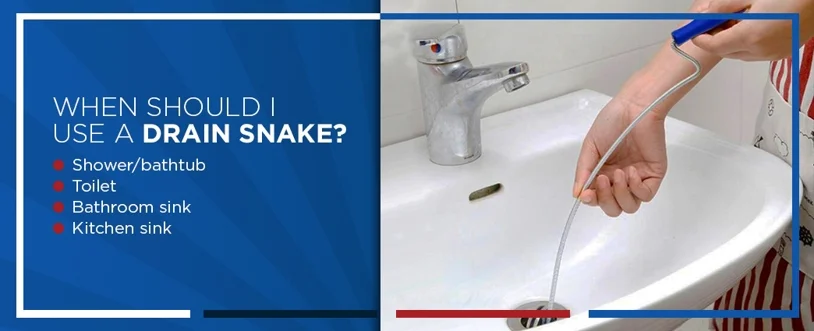
There are times when it's best to use a drain snake and times when a snake isn't your best option. Before you snake, it's smart to take some steps first to see whether you can resolve the problem without it. Let's take a look at some common drains throughout the home and what you can do to assess the problem before you pull out your drain snake.
- Shower/bathtub: When you have a clogged tub or shower, sometimes you can fix the clog by pouring a combination of baking soda and vinegar down the drain. Hot water can also help to break up clogs that form in tub and shower drains. Beware of harsh chemicals, though, as they can damage your plumbing. If vinegar or hot water doesn't dissolve the clog, then you can try snaking the drain.
- Toilet: For a clogged toilet, your first step should always be to plunge it. Start slow and then plunge vigorously, keeping the plunger pushed down to maintain a good seal. Keep at it for a while since it could take as many as 20 plunges or so to clear the blockage. If a plunger isn't taking care of the issue, then it's time to try snaking the toilet.
- Bathroom sink: A clogged bathroom sink is often easy to fix without the need for a snake. One thing to try is to remove the sink stopper so you can pull out any hair or other materials that may be slowing down the drain. You can also disconnect the drain trap and the trap arm to see if any objects are caught in there.
- Kitchen sink: A kitchen sink can be clogged by grease and bits of food that go down the drain. To unclog a kitchen sink, start by plunging it. If you have a two-sided sink, cover the functioning drain while you plunge the clogged one so you can maintain suction. In some cases, clogs occur because the disposal stops working or becomes jammed. If your garbage disposal isn't functioning, then you'll want to fix it or unclog it and see if that resolves the issue.
What Are the Pros and Cons of Using a Snake?
Using a snake to clear a drain has some valuable benefits. This tool is:
- Accessible: Getting a drain snake is easy since you can typically pick one up at your local hardware or home improvement store. You may also find a couple of basic options available in a department store.
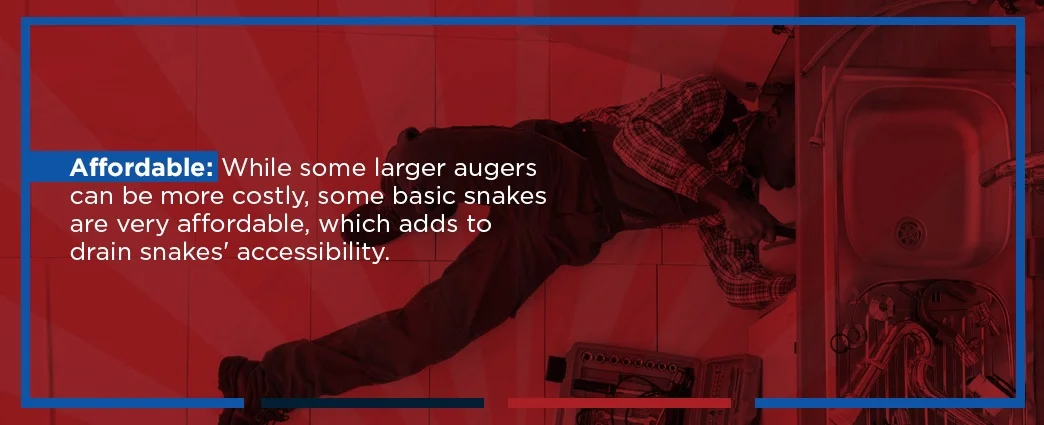
- Affordable: While some larger augers can be more costly, some basic snakes are very affordable, which adds to drain snakes' accessibility. If cost is a concern, you might try to make your own drain snake.
- Simple: Another pro of using a drain snake is that it requires little skill or experience. By following the instructions in this post and reading the instruction manual that comes with your drain snake, you should be able to operate it correctly.
- Effective: Ultimately, the biggest pro of a drain snake is that, in many cases, it can get the job done. As we'll see, there are some situations where a drain snake won't fix the problem, but in many cases, a drain snake can save the day (and your drain).
While using a snake has some advantages, it also has some drawbacks. The cons of using a drain snake are that it:
- Can't grab some materials: Some types of clogs can be tricky to hook onto with a drain snake. A snake might be good at grabbing onto hair or solid clogs, but not so good at grabbing greasy or slippery clogs.
- May leave some debris: Even when a drain snake successfully unclogs a drain, it can leave material behind, especially if the auger is smaller than the pipe's diameter. Bits of the material can be left clinging to the insides of pipes, leading to a repeat problem in the future.
- Can break off: One issue that can occur when you use a drain snake at home is that it could break off in the line. This is mainly an issue when it comes to cheaper models that can't handle too much tension while twisting.
- Can't always clear clogs: Overall, a drain snake is a great tool to try, but it cannot always solve the problem. Some clogs are just too dense or extensive to be cleared with a drain snake.
What Are the Different Types of Drain Snakes?
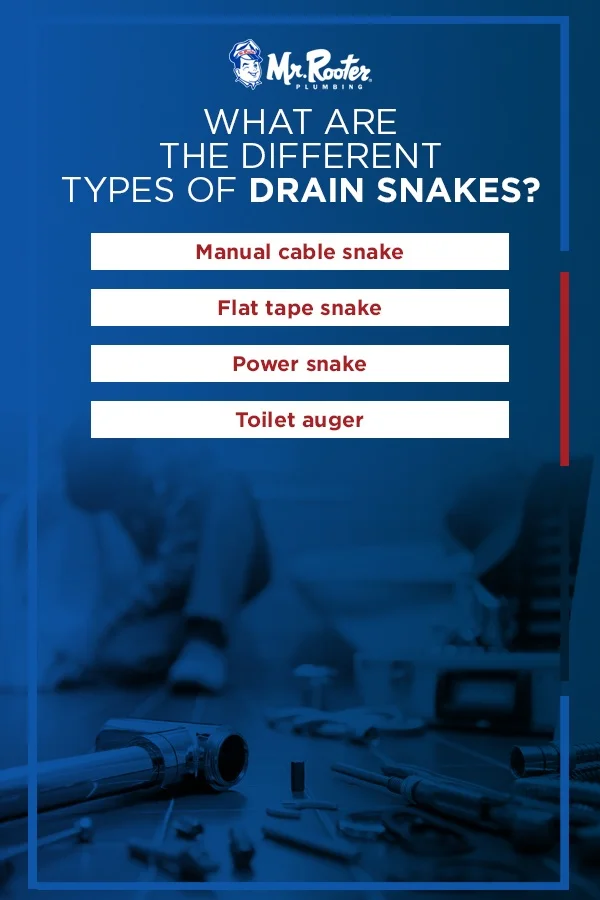
If you visit a hardware store, you're likely to see different types of drain snakes, sometimes called augers, on the shelf. Which one you should buy? Each type of drain snake is designed for a specific purpose. Some common types you might find include:
- Manual cable snake: The most basic option is a manual snake, also sometimes called a top snake or drum snake. This type of snake typically comes in 25- and 50-foot options. A basic manual snake is made of cable with a hook at the end. You simply feed it into the drain line and twist it to get a hold of the clog before pulling it back. Some models use a canister to hold the coiled-up cable so you can only pull out the length of cable you need. Because it is manually operated, this type of snake is one of the most affordable options.
- Flat tape snake: An option to consider if you have a clog in a narrow pipe (smaller than 2 inches in diameter) is a flat tape snake. This type of drain snake is similar to a manual cable snake but flatter. Another difference is that many flat tape snakes are made to push the clog forward rather than hook onto it and pull it up.
- Power snake: Power, or motorized, snakes are another option to consider. These snakes hook onto motors so you don't need to use elbow grease to operate them. Many models are designed to attach to a power tool head, like a drill. These snakes can clear tougher clogs than manual options.
- Toilet auger: When you have a toilet clog, the right snake to use is a toilet auger, aka a water closet auger. Toilet augers come in both manual and powered options. They work well for toilets since they are made from an extra-flexible cable. They are also designed with plastic and rubber covers so they are less likely to scratch the inside of the bowl.
The price of a drain snake might also influence your decision. In most cases, you're better off spending a bit more for a more reliable snake. You may also be able to rent a drain snake instead of buying one.
Drain Snake vs. Hanger: Can I Use a Wire Hanger to Unclog a Drain?
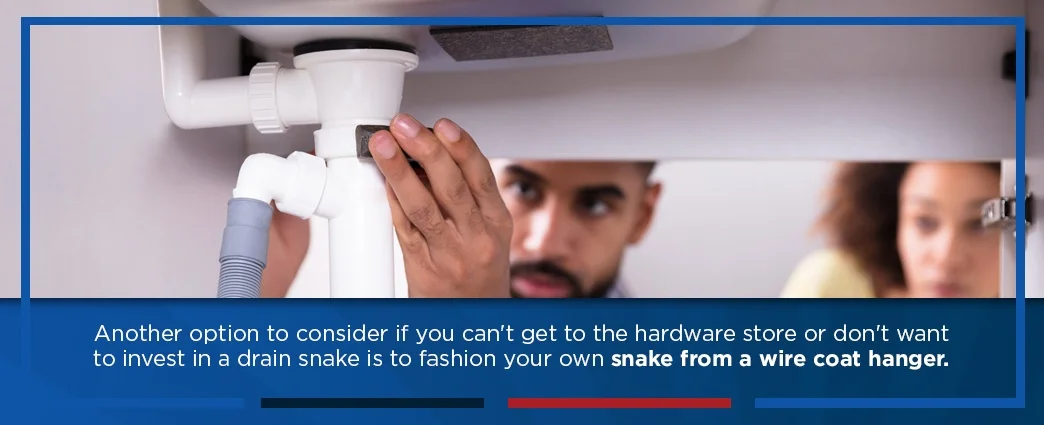
Another option to consider if you can't get to the hardware store or don't want to invest in a drain snake is to fashion your own snake from a wire coat hanger. To do this, use needle-nose pliers to take the hanger apart and stretch it into one long piece of wire. Pull the end of the wire back to make a hook.
To use your DIY snake, first, look down the drain with a flashlight to see if you can visually locate the clog. Then, feed the wire into the drain and attempt to hook onto the clog before pulling it back up. You may be able to pull part of the clog up but may need to repeat the process a few times in order to remove the whole clog.
While a wire hanger may work in some instances, it is not an effective substitute for a real auger all the time. Using a wire hanger also involves more manual work than using a store-bought snake.
How Do You Snake a Shower or Bathtub Drain?
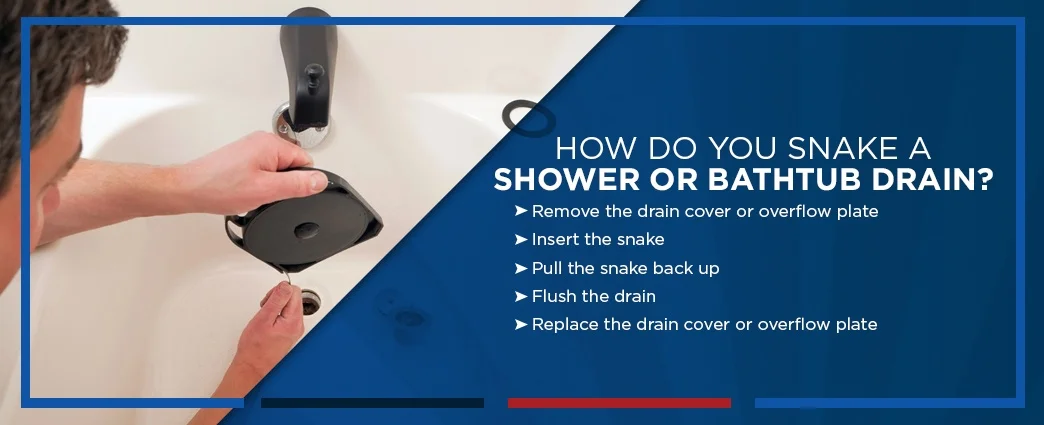
Showers and bathtubs can easily become clogged from materials like hair and soap that wash down the drain. When your shower or tub isn't draining properly and you suspect there's a clog, here's how to try removing it on your own:
- Remove the drain cover or overflow plate: For a shower, you'll need to remove the drain cover so you can get to the drain. There are many different types of shower drain covers. Each one requires a different method of removal. In many cases, it's as simple as using a screwdriver to remove the screws holding the cover down. For a bathtub, you'll need to remove the overflow plate below the faucet, not the drain stopper.
- Insert the snake: Once you've removed the drain cover or overflow plate, you can begin to lower the snake cable into the drain. Most clogs in a shower drain are in the P-trap, which is located just below the drain opening, so you may only need to insert the cable two or three feet. When you feel like the snake has run into the clog, turn it to hook onto the clog.
- Pull the snake back up: You can check to make sure you've cleared the blockage by running some water and seeing whether it trickles past the snake or backs up into the shower or tub. If it appears that you've dislodged the clog, reverse the rotational direction of the cable and pull the snake back up.
- Flush the drain: When you've removed a clog, you should run the shower or tub faucet for a couple of minutes to make sure the water is draining properly. The clog may be more extensive than you realized. In some cases, the running water is enough to rinse away the remaining pieces of debris the auger wasn't able to grab.
- Replace the drain cover or overflow plate: When you're satisfied that the clog has been removed and the shower or bathtub is draining properly, replace the shower drain cover or overflow plate.
How Do You Snake a Toilet?
Toilets often become clogged from materials that shouldn't be flushed, such as toys or wet wipes. Using a plunger is often enough to fix the clog. However, in some cases, you'll need to use a drain snake — specifically, a toilet auger. Here's how to snake a toilet:
- Prepare the area: Put on some gloves and cover the area around the toilet, either with old towels, a plastic tarp or another covering you wouldn't mind getting dirty.
- Insert the auger: Slide the auger into the toilet bowl. The metal end of the auger should descend into the drain so all you can see is the rubber or plastic casing around the cable.
- Lower the auger: Rotate the auger, either manually or with the help of a motor, so that the cable descends deeper into the drain until you feel it come into contact with a clog. In most cases, you will not have to go far before you reach the clog. You may have to reverse the direction a few times to successfully lower the cable.
- Pull the auger back up: When you have got a hold of the clog in your toilet, you can begin to reverse the direction of the auger to carefully pull it back up. Expect some splashing as the snake comes back up, especially if you're using a motorized tool.
- Flush the toilet: Once you have removed whatever was blocking the drain, then it's time to flush the toilet to make sure everything is clear. You may have to snake the toilet again to remove the whole clog.
How Do You Snake a Sink Drain?
When a kitchen or bathroom sink gets clogged, snaking the drain can often help to resolve the issue. Follow these steps to snake a kitchen drain or bathroom sink drain:
- Empty the P-trap: The first thing you'll want to do is unscrew and empty the P-trap, the curved section of pipe just below the sink. Keep a bucket under the P-trap while you loosen it so the water doesn't make a mess. ln some cases, the clog is located inside the P-trap, and cleaning it out solves the problem.
- Remove the trap arm: Next, you'll want to remove the trap arm, the section of pipe that connects the P-trap to the main drain stack in your wall. This is typically the best place to insert the auger, and in some cases, you may discover a clog in this section of pipe, allowing you to avoid snaking the drain altogether.

- Insert the snake: Now, you can insert the drain snake. The way you push the snake into the line will depend on what type of snake you have. For a bathroom sink, a flat tape snake is usually enough to do the trick. Whether you're using a manual or power snake, be careful to push the cable down once you make it to the main stack. With some plumbing setups, the snake may otherwise move forward into another sink connected horizontally.
- Pull the snake out: When the snake is experiencing a great deal of resistance, then you've likely located the clog. If you're using a flat tape snake, push it as far forward as possible since the goal is to move the clog down the line rather than pull it back up. Now, pull the snake back, being careful to minimize the mess under your sink.
- Restore plumbing and test: When you've successfully removed or dislodged the clog, you can put the P-trap and trap arm back in place. Be sure that all connections are tight so you don't get a leak under your sink. Once everything is back in place, try running the water to see whether it drains well.
How Do You Get a Drain Snake Around a Corner?

One of the trickiest parts of using a drain snake is getting around bends in the plumbing, especially right angles. Getting around corners becomes easier with practice, but a few tips will help you move your cable in the right direction.
Bend the end of the snake about 3 or 4 inches from the end before you insert it so it will more easily go around the corner when it encounters it. You can also try pulling back on the cable just a bit when you get to a corner. Doing so will give you a chance to reposition the snake so that it is angled toward the bend it has to make. Then, you can continue to push the cable forward.
What Should You Do When a Drain Snake Isn't Working?

There are several ways you can unclog a drain, so don't automatically lose hope if using a drain snake doesn't work. Usually, if the drain snake does not do the job of unclogging a drain, it is time to call in the professionals.
A licensed plumber can use their expertise to assess the situation, diagnose the problem and then fix it. The drain augers that plumbers have access to are more heavy-duty than the kinds you can buy at the store, so they may be able to clear clogs your drain snake can't. Having a drain snaked tends to be a pretty affordable service, so don't hesitate to call in the pros when needed.
Contact Mr. Rooter for Your Drain Cleaning Needs
At Mr. Rooter Plumbing, we know how inconvenient a drain clog can be — especially a stubborn clog you can't clear on your own. Fortunately, Mr. Rooter of Greater Syracuse is just a phone call away if you need professional help clearing a drain. One of our licensed plumbers can take care of the issue swiftly so you can get back to normal and enjoy a functioning plumbing system. Contact us today for a quote.


